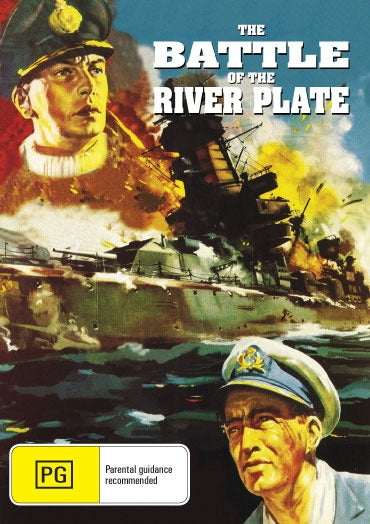rareandcollectibledvds
Battle Of The River Plate on DVD, Action, John Gregson, Anthony Quayle
Battle Of The River Plate on DVD, Action, John Gregson, Anthony Quayle
IMPORTANT
Before You Order
DO YOU WANT A DVD OR A DOWNLOAD?
A DVD WILL BE DELIVERED VIA THE POST
A DOWNLOAD IS NOT A DVD BUT THE TRANSFER VIA EMAIL OF THE DIGITAL FILE OF THE DVD
Couldn't load pickup availability
In the fall of 1939, the German heavy cruiser (referred to as a pocket battleship) Graf Spee seems to have command of the Atlantic. In the first three months of World War II, she was responsible for sinking nine ships. The British sent three cruisers commanded by Commodore Henry Harwood to confront her. The battle took place on December 13, 1939 and the British came out on top. The Graf Spee headed for the neutral harbor of Montevideo, Uruguay. They were given only a short time to effect repairs and the British did their best to make them believe a British fleet of six or eight ships awaited them. Rather than chance the loss of his men, the German Captain ordered the Graf Spee scuttled.
STARS: John Gregson, Anthony Quayle, Peter Finch
119 min | Action, Adventure, Drama | 1956 | Color
Movies with low demand and/or out of print are manufactured-to-order using high quality recordable DVDs. Please read FAQs if unsure, or send a query.
All DVDs are Region 0 and are guaranteed to play on any DVD player in any country in the world
Satisfaction Guarantee – if you are not satisfied with any aspect of your purchase then we will explore all options to rectify the issue
COMBINED POSTAGE: ONLY CHARGED FOR THE FIRST DVD ALL OTHERS IN A MULTIPLE ORDER ARE POST FREE
Postage: Free In Australia.
Postage: Rest Of The World at Table Rate
All DVDs come in a DVD case with color artwork and printed disc
All DVDs are available as an MPEG4 file sent to you via an email link. Save on postage and waiting time. Transfer can take up to 12 hours depending on the time zone you are in.
Excellent British Naval Drama. A Must-see.
I love this movie. Peter Finch stars as Capt. Langsdorf of the German "pocket" battleship Admiral Graf Spee. He is perfect; from the almost swashbuckly entrance and dialogue with Capt. Dove, a merchant captain whose ship they've just sunk, to the trance-like confusion at the end of the film. There are so many great actors in this film its almost like "the Longest Day," except these guys act. Christopher Lee as Manolo, the jealous bar owner; Anthony Quayle as Commodore Harwood; Anthony Newly as a sailor with about three lines that he still manages to over-act; and John Gregson, who plays Capt. Bell of the British cruiser Exeter. Well known, and often quirky co-directors and writers, Emeric Pressburger and Michael Powell bring together spectacular shots of many of the actual ships involved in the battle with an almost ensemble-like feeling in the cast. From the British Ambassador with the no-nonsense, sharped-tongued secretary to the goofy-gaucho interpreter for the reporter, Mike Fowler, these powerfully presented characters intensify the real drama of this battle. It wasn't just a sea battle, it was political, involving sailors, spies, and bad cafe singing.
Must watch Maritime Movie!
I really really like this film. Peter Finch is outstanding as Captain Langsdorf of the German Battleship Admiral Graf Spee. I love the swashbuckling entrance that he makes with Captain Dove (He is the captain of a merchant ship that was sunk by the Admiral Graf Spee). There are so many stand out actors in this film, Christopher Lee, Anthony Quale and John Gregson. The Directors Emeric Pressburger and Michael Powell both work together really well, the cinematography is just amazing, their choice of shots outstanding. Every single character in this film is just outstanding. I think the shots of real ships, that took place during the real battles just makes it for me. I feel like I am on the boat watching action real time! Well worth watching, not to be missed.


